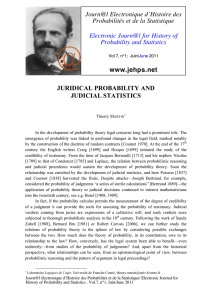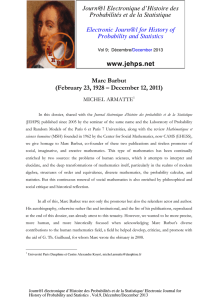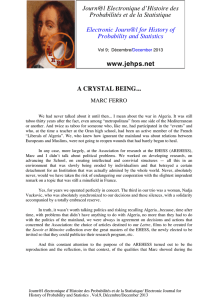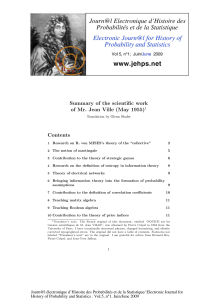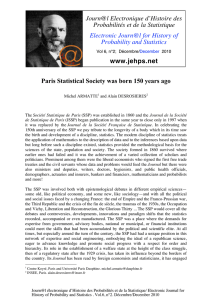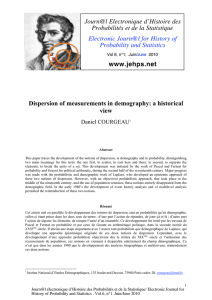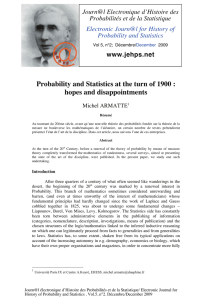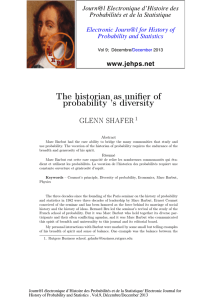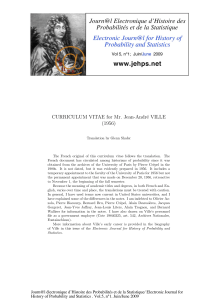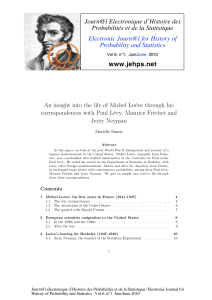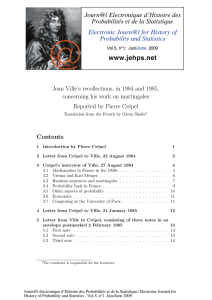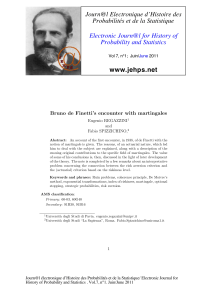Game theory, duality, economic growth
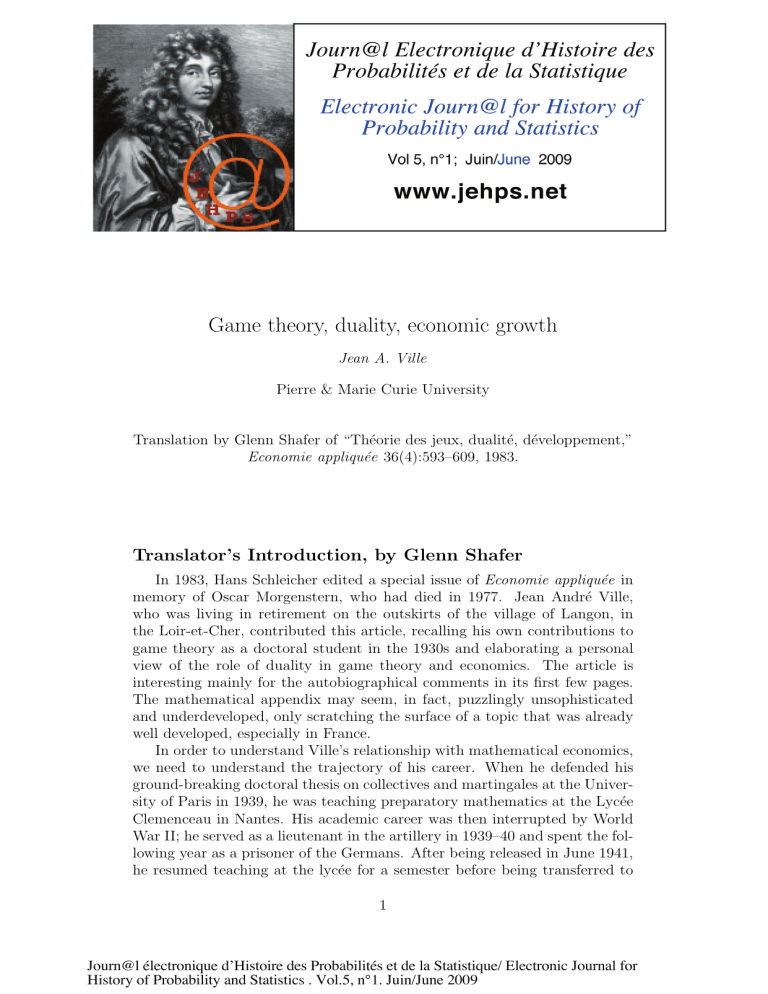
Game theory, duality, economic growth
Jean A. Ville
Pierre & Marie Curie University
Translation by Glenn Shafer of “Th´eorie des jeux, dualit´e, d´eveloppement,”
Economie appliqu´ee 36(4):593–609, 1983.
Translator’s Introduction, by Glenn Shafer
In 1983, Hans Schleicher edited a special issue of Economie appliqu´ee in memory of Oscar Morgenstern, who had died in 1977. Jean Andr´e Ville, who was living in retirement on the outskirts of the village of Langon, in the Loir-et-Cher, contributed this article, recalling his own contributions to game theory as a doctoral student in the 1930s and elaborating a personal view of the role of duality in game theory and economics. The article is interesting mainly for the autobiographical comments in its first few pages.
The mathematical appendix may seem, in fact, puzzlingly unsophisticated and underdeveloped, only scratching the surface of a topic that was already well developed, especially in France.
In order to understand Ville’s relationship with mathematical economics, we need to understand the trajectory of his career. When he defended his ground-breaking doctoral thesis on collectives and martingales at the University of Paris in 1939, he was teaching preparatory mathematics at the Lyc´ee
Clemenceau in Nantes. His academic career was then interrupted by World
War II; he served as a lieutenant in the artillery in 1939–40 and spent the following year as a prisoner of the Germans. After being released in June 1941, he resumed teaching at the lyc´ee for a semester before being transferred to
1
Journ@l électronique d’Histoire des Probabilités et de la Statistique/ Electronic Journal for
History of Probability and Statistics . Vol.5, n°1. Juin/June 2009
the Faculty of Sciences at Poitiers in January 1942 and to the Faculty of Sciences at Lyon in November 1943. His research during this period was mainly in probability and statistics, and he continually sought a university appointment in this field. But posts in probability and statistics hardly existed in the
French universities at the time, and his main teaching duties at Poitiers and
Lyon were in calculus and rational mechanics. Living in Paris and commuting to Poitiers and Lyon, he became increasingly involved in consulting with the Paris telecommunications laboratory of the manufacturer SACM (Soci´et´e alsacienne de constructions m´ecaniques), and by 1946 his research interests were primarily in information and signal theory. After he was passed over for the chair of rational mechanics at Lyon, he managed to extract an indefinite leave of absence from the Ministry of Education, and he spent the following ten years without an academic salary, working for SACM and also teaching as an adjunct at the University of Paris’s statistical institute (ISUP) and elsewhere.
During his ten years at the margins of French academics, Ville’s work was impressive but applied. Most of his publications were in engineering journals, especially Cˆables et Transmissions . He played an important role in SACM’s development of electronics and computing, and he was the intellectual motor in their consulting for the French military. At ISUP, he was part of a community that educated Paris students in the new fields of applied mathematics that were not yet respectable in the university. Emile
Borel and others concerned with the narrowness of French university mathematics had chartered ISUP in the 1920s; it offered courses independently of the university and awarded certificates, not university degrees. It expanded greatly under Georges Darmois, and in the 1950s it was the main source of instruction in Paris not only in statistics but also in operations research, game theory, and mathematical economics. Ville taught information theory, matrix algebra, Boolean algebra, and demography at ISUP.
In 1956, Darmois and Joseph P´er`es, dean of the Paris Faculty of Sciences, decided to appoint Ville to their faculty. The University of Paris was far behind in computing, not only relative to universities in other countries but also relative to some provincial French universities that had their own engineering schools. Ville could help in this field; he could teach the theory of computing, and he could bring experts in the practical aspects of computing to the university as adjuncts. But he had no academic standing in computing. Instead, his main academic reputation stemmed from two articles in what we would now call mathematical economics: a celebrated article on von Neumann’s minimax theorem in a book Borel had published in 1938, and an article on utility theory, inspired by his teaching, that he had published at Lyon in 1946. So his appointment was labeled ´econom´etrie . He was appointed maˆıtre de conf´erences d’´econom´etrie in 1956 and awarded a newly created chair in ´econom´etrie in 1959.
Today, “econometrics” refers principally to the study of statistical methods for economic time series. But in the 1950s, it could be used more broadly
2
Journ@l électronique d’Histoire des Probabilités et de la Statistique/ Electronic Journal for
History of Probability and Statistics . Vol.5, n°1. Juin/June 2009
the Faculty of Sciences at Poitiers in January 1942 and to the Faculty of Sciences at Lyon in November 1943. His research during this period was mainly in probability and statistics, and he continually sought a university appointment in this field. But posts in probability and statistics hardly existed in the
French universities at the time, and his main teaching duties at Poitiers and
Lyon were in calculus and rational mechanics. Living in Paris and commuting to Poitiers and Lyon, he became increasingly involved in consulting with the Paris telecommunications laboratory of the manufacturer SACM (Soci´et´e alsacienne de constructions m´ecaniques), and by 1946 his research interests were primarily in information and signal theory. After he was passed over for the chair of rational mechanics at Lyon, he managed to extract an indefinite leave of absence from the Ministry of Education, and he spent the following ten years without an academic salary, working for SACM and also teaching as an adjunct at the University of Paris’s statistical institute (ISUP) and elsewhere.
During his ten years at the margins of French academics, Ville’s work was impressive but applied. Most of his publications were in engineering journals, especially Cˆables et Transmissions . He played an important role in SACM’s development of electronics and computing, and he was the intellectual motor in their consulting for the French military. At ISUP, he was part of a community that educated Paris students in the new fields of applied mathematics that were not yet respectable in the university. Emile
Borel and others concerned with the narrowness of French university mathematics had chartered ISUP in the 1920s; it offered courses independently of the university and awarded certificates, not university degrees. It expanded greatly under Georges Darmois, and in the 1950s it was the main source of instruction in Paris not only in statistics but also in operations research, game theory, and mathematical economics. Ville taught information theory, matrix algebra, Boolean algebra, and demography at ISUP.
In 1956, Darmois and Joseph P´er`es, dean of the Paris Faculty of Sciences, decided to appoint Ville to their faculty. The University of Paris was far behind in computing, not only relative to universities in other countries but also relative to some provincial French universities that had their own engineering schools. Ville could help in this field; he could teach the theory of computing, and he could bring experts in the practical aspects of computing to the university as adjuncts. But he had no academic standing in computing. Instead, his main academic reputation stemmed from two articles in what we would now call mathematical economics: a celebrated article on von Neumann’s minimax theorem in a book Borel had published in 1938, and an article on utility theory, inspired by his teaching, that he had published at Lyon in 1946. So his appointment was labeled ´econom´etrie . He was appointed maˆıtre de conf´erences d’´econom´etrie in 1956 and awarded a newly created chair in ´econom´etrie in 1959.
Today, “econometrics” refers principally to the study of statistical methods for economic time series. But in the 1950s, it could be used more broadly
2 as a synonym for mathematical economics, as in the title of the journal
Econometrica . Ville was not, however, a professor of economics. In the
French system, economics belonged to the Faculty of Law. Ville was in the
Faculty of Sciences, where he was a professor of mathematics. Instead of saying that he was a professor of ´econom´etrie , a term that must have been confusing even then, he would sometimes explain that he was a professor of math´ematiques ´economiques – economic mathematics. He remained on the faculty of the University of Paris from 1956 until his retirement in 1978. In
1971, the university was divided into a dozen universities. Most of the Faculty of Sciences became part of University VI, which was later named after
Pierre and Marie Curie. The Faculty of Law became part of University I. At
University VI, Ville continued to teach the theory of computing to undergraduates and developed a masters program in mathematical economics in cooperation with Claude Fourgeaud at University I. His small laboratory of economic mathematics was part of mathematics until around the time of his retirement, when it became associated with computer science ( informatique in French).
A glance at his list of publications in this issue of the Electronic Journal for History of Probability and Statistics reveals that Ville was not very productive intellectually after his return to the university in 1956. It seems fair to say that his career as a consultant had left him without a real intellectual agenda. He had little interest in the modern academic enterprise to which the University of Paris rallied in the 1960s and 1970s, with its conferences, seminars, and increasingly technical questions. The doctoral students he hired as assistants participated in a seminar that he supposedly co-chaired with Claude Fourgeaud, but he never attended its sessions.
In his retirement, Ville was isolated, living in awkward conditions in the countryside with the strong-willed and increasingly eccentric wife to whom he had always been devoted. This article is testimony, however, that he was still thinking, in his 70s, about how to live up to his title as a distinguished professor of economic mathematics.
Further information on Ville’s career and contributions is provided by other articles and documents in this issue of the Electronic Journal for History of Probability and Statistics . The role of ISUP in operations research in
France in the 1950s is discussed by Bernard Roy in “Regard historique sur la place de la RO-AD en France” in Cahier du LAMSADE 237, May 2006. The importance of Ville’s 1946 article on utility theory is discussed by Fran¸cois
Gardes and Pierre Garrouste in “Jean Ville’s contribution to the integrability debate: The mystery of a lost theorem” in History of Political Economy ,
38(supplement):86–105, 2006. His role in the development of digital methods at SACM is described by Gabriel Dureau in “Les techniques num´eriques et l’informatique `a la Soci´et´e Alsacienne de Constructions M´ecaniques et `a la
Soci´et´e ALCATEL” in Deuxi`eme Colloque sur l’Histoire de l’Informatique en France , edited by Philippe Chatelin and Pierre Mounier-Kuhn, vol. 2, pp.
129–146, Conservatoire National des Arts et M´etiers, Paris, 1990.
3
Journ@l électronique d’Histoire des Probabilités et de la Statistique/ Electronic Journal for
History of Probability and Statistics . Vol.5, n°1. Juin/June 2009
I am grateful to the many who have helped me with this translation and with information about Ville’s career, especially Pierre Cr´epel, Richard
McLean, Ethier Stewart, Bernard Walliser, and two eminent and recently deceased scholars, Georges Th. Guilbaud and Jean-Yves Jaffray. I also thank the editor of Economie appliqu´ee , Rolande Borelly, for permission to publish the translation. I have silently corrected obvious typographical errors and taken some liberties to make the English flow naturally.
4
Journ@l électronique d’Histoire des Probabilités et de la Statistique/ Electronic Journal for
History of Probability and Statistics . Vol.5, n°1. Juin/June 2009
I am grateful to the many who have helped me with this translation and with information about Ville’s career, especially Pierre Cr´epel, Richard
McLean, Ethier Stewart, Bernard Walliser, and two eminent and recently deceased scholars, Georges Th. Guilbaud and Jean-Yves Jaffray. I also thank the editor of Economie appliqu´ee , Rolande Borelly, for permission to publish the translation. I have silently corrected obvious typographical errors and taken some liberties to make the English flow naturally.
4
Game theory, duality, economic growth
by Jean A. Ville
Not the least of Oscar Morgenstern’s achievements was to promote game theory to the point where it became a respectable discipline. At a moment when the theory is the subject of a colloquium at the College of France, it may seem bizarre to raise the question of whether it is a respectable discipline. But when I was a student, even probability theory was looked upon as an honorable pastime for celebrated mathematicians, who had already distinguished themselves in other branches of pure, not to say genuine, mathematics, such as analysis.
Other pastimes kept probability company. Among them one counted
Boolean algebra, the binary number system, Fran¸cois Divisia’s rational economics, 1 and mathematical logic, then called logistic.
2 This attitude of contempt was expressed by an almost complete absence of instruction in these disciplines and a distrust of the young people attracted by them, who were suspected of being interested in entertainment rather than serious research.
Emile Borel came out of the theory of functions and measure theory,
Maurice Fr´echet out of the topology of abstract spaces, George Darmois out of relativity. They had excelled sufficiently in these serious occupations to have gained the right to amuse themselves.
As for game theory, the very topic made it yet more a matter of entertainment. Analytical probability theory found some tolerance because of its close connection at the time with the theory of heat. Kolmogorov’s axiomatization was accepted because it started with a “field.” I myself had been interested in games only in the case where a player fought against chance armed with a martingale.
Emile Borel gave a course on games of chance: gambler’s ruin, Pascal’s problem of dividing the stakes. Borel had formalized games where players chose certain acts (a card game in which there is bidding, for example), the rest being random (the hands, for example). These were not games of “pure chance”. The procedure used was that of “manuals.” Each player had a library of instruction manuals. Each manual stated precisely what one should do in every situation. The preparation of the manuals took the randomness into account, but the instructions were not random. They were imperious and without escape hatches (unambiguous). Everything was settled, at the beginning of a match, by the choice of a manual. Player A having “Amanuals” and Player B having “B-manuals,” we naturally want to establish an ordering of the manuals, to distinguish the “good” ones from the “bad.”
1 Translator’s note: The French economist Fran¸cois Divisia (1889–1964) published his treatise Economique rationnelle in 1928.
2 Translator’s note: In French, “la logistique.” This usage is still sanctioned by dictionaries in both French and English.
5
Journ@l électronique d’Histoire des Probabilités et de la Statistique/ Electronic Journal for
History of Probability and Statistics . Vol.5, n°1. Juin/June 2009
A preorder is given by “this A-manual beats this B-manual.” But as simple examples show, transitivity is not necessarily to be expected. It is possible that manual A
1 beats manual B
1
, which beats A
2
, which beats B
2
, which beats A
1
. Here is the well known fact that you can defeat your adversary more easily if you know what he is going to do. You can get around this difficulty by introducing mixed strategies: you draw the manual you are going to use at random, using appropriate probabilities. Skill is a matter of choosing the probabilities well.
For two players in a zero-sum game, there arises for each a Maximin, the minimum gain guaranteed by his own strategy, and a Minimax, which the adversary can keep him from exceeding. The Maximin is obviously the smaller of the two. In simple examples one finds that the two bounds are equal, but is this the case in general? The question was important, because the gap between the two was theoretically the last refuge of uncertainty. J.
von Neumann gave the response in his article in Mathematische Annalen : there is no gap.
It was out of the question to present the proof in an elementary course.
I looked for a proof that would bring out the true reason for the equation
Minimax = Maximin. The starting point appeared in a simple drawing: if two planes intersecting in a horizontal line form a gabled roof, the peak corresponds to the Maximin. One can combine the two planes linearly by balancing a horizontal plane on this peak; this is precisely the combination
(with positive coefficients) we seek. This horizontal plane through the peak of the roof gives the Minimax. The generalization involves convex pyramids, of as high a dimension as necessary; this shows the basic role of convexity.
No one had noticed that it was a matter of convexity, and this inspired a certain amount of scorn, except on the part of John von Neumann himself, who noted the situation in Econometrica with the best grace in the world.
This result remained a paragraph in the theory of games in the proper sense of the term, say the sense of the Chevalier de M´er´e. The preoccupations of the moment were different. One tried to imitate chance, or to show that it could not be imitated, or to generalize Markov. Emile Borel asked if the decimals of Pi were distributed at random, and one of his students asked if one would get logarithmically distributed pseudo primes if Erastothenes’s sieve were replaced with drawing at random. The strong law of large numbers was also “on the docket.”
In Vienna, I had had the good fortune to be able to attend Karl Menger’s seminar. In its organization, this seminar was a marvel. The program was very loose, and people talked about every which thing. The result was that every week gave birth to a new idea, small or large, but always attractive.
Back in Paris, I had started a seminar on probability theory. Wolfgang
Doeblin joined it, and Emile Borel adopted it. The most varied questions were taken up there, like that of pseudo primes. But games were still only games.
Then came the war, where, to the greatest grief of Probability, Wolfgang
6
Journ@l électronique d’Histoire des Probabilités et de la Statistique/ Electronic Journal for
History of Probability and Statistics . Vol.5, n°1. Juin/June 2009
A preorder is given by “this A-manual beats this B-manual.” But as simple examples show, transitivity is not necessarily to be expected. It is possible that manual A
1 beats manual B
1
, which beats A
2
, which beats B
2
, which beats A
1
. Here is the well known fact that you can defeat your adversary more easily if you know what he is going to do. You can get around this difficulty by introducing mixed strategies: you draw the manual you are going to use at random, using appropriate probabilities. Skill is a matter of choosing the probabilities well.
For two players in a zero-sum game, there arises for each a Maximin, the minimum gain guaranteed by his own strategy, and a Minimax, which the adversary can keep him from exceeding. The Maximin is obviously the smaller of the two. In simple examples one finds that the two bounds are equal, but is this the case in general? The question was important, because the gap between the two was theoretically the last refuge of uncertainty. J.
von Neumann gave the response in his article in Mathematische Annalen : there is no gap.
It was out of the question to present the proof in an elementary course.
I looked for a proof that would bring out the true reason for the equation
Minimax = Maximin. The starting point appeared in a simple drawing: if two planes intersecting in a horizontal line form a gabled roof, the peak corresponds to the Maximin. One can combine the two planes linearly by balancing a horizontal plane on this peak; this is precisely the combination
(with positive coefficients) we seek. This horizontal plane through the peak of the roof gives the Minimax. The generalization involves convex pyramids, of as high a dimension as necessary; this shows the basic role of convexity.
No one had noticed that it was a matter of convexity, and this inspired a certain amount of scorn, except on the part of John von Neumann himself, who noted the situation in Econometrica with the best grace in the world.
This result remained a paragraph in the theory of games in the proper sense of the term, say the sense of the Chevalier de M´er´e. The preoccupations of the moment were different. One tried to imitate chance, or to show that it could not be imitated, or to generalize Markov. Emile Borel asked if the decimals of Pi were distributed at random, and one of his students asked if one would get logarithmically distributed pseudo primes if Erastothenes’s sieve were replaced with drawing at random. The strong law of large numbers was also “on the docket.”
In Vienna, I had had the good fortune to be able to attend Karl Menger’s seminar. In its organization, this seminar was a marvel. The program was very loose, and people talked about every which thing. The result was that every week gave birth to a new idea, small or large, but always attractive.
Back in Paris, I had started a seminar on probability theory. Wolfgang
Doeblin joined it, and Emile Borel adopted it. The most varied questions were taken up there, like that of pseudo primes. But games were still only games.
Then came the war, where, to the greatest grief of Probability, Wolfgang
6
Doeblin was lost. When we came back, I heard nothing more about games.
I was alone in France, holding on to a subject that interested no one. Emile
Borel had even said to me: “It should be time you did some analysis.” I was still too young to amuse myself with games.
This was the way it was, until operations research, linear programming, and game theory applied to economics took off in the U.S.A. I heard about it from Mr. Indjoudjian, 3 returning from a mission. He told me about the sensation created by the work of von Neumann and Morgenstern. Game theory had acquired prestige, and I was cited over there before being cited in France. Later Oskar Morgenstern talked to me about the quite difficult research they did to rediscover what he called the missing link in game theory
– i.e., my work.
Game theory found its place. Thanks to the work of these two scholars, it had acquired a general formalism. In the end – here is how daring their thought was – coalitions and side payments, considered cheating in the game theory of games, became objects of study in the game theory of economics.
Economics could adopt game theory without shame, just as it had adopted matrices with positive elements, which had already distinguished themselves in pure mathematics under Frobenius’s tutelage. Operations research promoted programming, which reminded us of the basic role of duality.
It then emerged that duality was the connection between certain economic concepts and certain aspects of game theory.
As for the Minimax theorem, its proof by duality is even simpler than its proof by linear programming. It comes down to showing that there is a Nash equilibrium and that the probabilities given the two players are dual.
Even with matrix games, even with mixed strategies, there remains the irritating question of games with three players, or of non-zero sum games of two players. We have to find a supplementary principle, an “ethical rule” to choose among the Nash equilibria and rule out cheating.
In a symmetric zero-sum game, the ethical rule is the equality of gains.
In the elementary case where three players each lay down a coin, gambling that the side they put up will be different from that of the other two players, the rule requires each player to choose between the two sides of his coin with probabilities 1 / 2 each. But when the game is not symmetric, we must impute choices and show they are compatible with a Nash equilibrium. Coalitions can then be useful, not to be implemented but to serve as a measure, to rank the players by their strength of attraction. For example, we can impute to each player the minimum he is guaranteed when playing against the coalition of the others, for a fixed sum, the same for all. A game where this is compatible with a Nash equilibrium is symmetrizable. The situation is similar in
3 Translator’s note: Concerning the career of Dikran Indjoudjian, a French industrialist who promoted operations research as a way to catch up with American industry, see the interview by Bernard Colasse and Francis Pav´e, “Parcours d’un Grand Banquier d’Affaires,” in Annales des Mines , December 2000, pp. 4–15. Indjoudjian was one of Ville’s fellow adjunct professors at ISUP.
7
Journ@l électronique d’Histoire des Probabilités et de la Statistique/ Electronic Journal for
History of Probability and Statistics . Vol.5, n°1. Juin/June 2009
a non-zero sum game of two players, if we introduce a fictional third player, who is passive but may enjoy certain rights under the ethical rules.
The probabilities in mixed strategies give weights for aggregating the numbers in the payoff matrices. In the case of a matrix A of payoffs for two players in a zero-sum game, in particular, a column of probabilities allows us to calculate a weighted Cartesian distance between rows, which allows us to group strategies using, for example, Benz´ecri’s correspondence analysis.
This is an aggregation. We might also be concerned with aggregation in a technology matrix.
Indeed, consider the scalar P AQ , where A is a technology matrix, Q a vector of amounts of the different goods (column vector), and P a vector of prices for raw materials (row vector). Each column of A corresponds to a good and gives the amounts of the raw materials together needed to manufacture it. Each row of A corresponds to a raw material and shows how much of one or another of the goods would have to be manufactured to use up the supply of the raw material.
4 The vector AQ is the vector of supplies.
The vector P A is the vector of costs of production. There is more duality.
The manufacturer wants to minimize P AQ (it is an expense). The supplier of raw materials wants to maximize P AQ (it is revenue). But the entries in P and Q are not probabilities. We must normalize them by multiplying by weights. For P , the weights have to be quantities, giving a vector M of sample quantities for the raw materials. For Q , the weights have to be prices, giving a vector V of sample prices.
The condition V Q = 1 keeps the production from being zero. The condition P M = 1 keeps the supplier of the raw materials from setting exaggerated prices. We are brought back to a game, but in the struggle some p and some q will come out zero. This is catastrophe: manufacturers unemployed, suppliers without sales. This catastrophe is what “failure of full employment” of the manuals means in a real game. For an arbitrary matrix, there is
“unemployment” of certain “suicidal” manuals. The technology matrix A is independent of our will. But M and V are dependent on it. Choosing them is required, as it were. They cannot be just anything. Here is where the duality between profit and full employment arises. Here is where the social game is really played. The calculations become too complicated for a literary exposition.
To summarize: Duality, a kind of dialectic. Imputation, a kind of ethics.
4 Translator’s note: Readers unfamiliar with technology matrices may find a simple example helpful. Suppose we manufacture only milk and bread, using only two raw materials, labor and land. It takes 10 hours of labor and 2 acres of land to produce a ton of milk, 20 hours of labor and 1 acre of land to produce a ton of bread. Labor costs $5 an hour, and land rents for $50 an acre. Consumers demand 3 tons of milk and 4 tons of bread. Then
P =
5 50
, A =
10 20
2 1
, Q =
3
4
.
The total cost, P AQ , will be $1050.
8
Journ@l électronique d’Histoire des Probabilités et de la Statistique/ Electronic Journal for
History of Probability and Statistics . Vol.5, n°1. Juin/June 2009
a non-zero sum game of two players, if we introduce a fictional third player, who is passive but may enjoy certain rights under the ethical rules.
The probabilities in mixed strategies give weights for aggregating the numbers in the payoff matrices. In the case of a matrix A of payoffs for two players in a zero-sum game, in particular, a column of probabilities allows us to calculate a weighted Cartesian distance between rows, which allows us to group strategies using, for example, Benz´ecri’s correspondence analysis.
This is an aggregation. We might also be concerned with aggregation in a technology matrix.
Indeed, consider the scalar P AQ , where A is a technology matrix, Q a vector of amounts of the different goods (column vector), and P a vector of prices for raw materials (row vector). Each column of A corresponds to a good and gives the amounts of the raw materials together needed to manufacture it. Each row of A corresponds to a raw material and shows how much of one or another of the goods would have to be manufactured to use up the supply of the raw material.
4 The vector AQ is the vector of supplies.
The vector P A is the vector of costs of production. There is more duality.
The manufacturer wants to minimize P AQ (it is an expense). The supplier of raw materials wants to maximize P AQ (it is revenue). But the entries in P and Q are not probabilities. We must normalize them by multiplying by weights. For P , the weights have to be quantities, giving a vector M of sample quantities for the raw materials. For Q , the weights have to be prices, giving a vector V of sample prices.
The condition V Q = 1 keeps the production from being zero. The condition P M = 1 keeps the supplier of the raw materials from setting exaggerated prices. We are brought back to a game, but in the struggle some p and some q will come out zero. This is catastrophe: manufacturers unemployed, suppliers without sales. This catastrophe is what “failure of full employment” of the manuals means in a real game. For an arbitrary matrix, there is
“unemployment” of certain “suicidal” manuals. The technology matrix A is independent of our will. But M and V are dependent on it. Choosing them is required, as it were. They cannot be just anything. Here is where the duality between profit and full employment arises. Here is where the social game is really played. The calculations become too complicated for a literary exposition.
To summarize: Duality, a kind of dialectic. Imputation, a kind of ethics.
4 Translator’s note: Readers unfamiliar with technology matrices may find a simple example helpful. Suppose we manufacture only milk and bread, using only two raw materials, labor and land. It takes 10 hours of labor and 2 acres of land to produce a ton of milk, 20 hours of labor and 1 acre of land to produce a ton of bread. Labor costs $5 an hour, and land rents for $50 an acre. Consumers demand 3 tons of milk and 4 tons of bread. Then
P =
5 50
, A =
10 20
2 1
, Q =
3
4
.
The total cost, P AQ , will be $1050.
8
Nash equilibrium, an incentive to work. Here is game theory’s contribution to economics.
Mathematical appendix
The most elementary duality arises when we compare two products involving a matrix a : its product with a column vector on its right and its product with a row vector on its left.
For a system of linear equations ax = b, a and b being given, the non-existence of a column vector x is equivalent to the existence of a row vector u such that ua = 0 and ub = 0 .
For the system of linear inequalities ax ≤ b, the non-existence of x is equivalent to the existence of u such that u ≥ 0 , ua = 0 , and ub < 0 .
These relationships can be interpreted as a sort of contest between a player X who wins if he finds a solution x and a player U who wins if he finds a solution u .
J
1
Now let us look at game theory, first of all the theory with two players and J
2
. These players can adopt attitudes x result of their choices, they obtain gains
1 and x
2
, respectively. As a
A
1
( x
1
, x
2
) and A
2
( x
2
, x
1
) respectively.
Player J
1 tries to choose x
1 to maximize A
1
; player J
2 tries to choose x
2 to maximize A
2
. Formulated in this way, the problem does not make sense, because two individuals are involved. Game theory’s purpose is not merely to solve a well formulated problem but also to formulate a problem for which one wants a solution. This second task is carried out by considering solutions that one judges to be acceptable and looking for a formulation that leads to them.
So far as J
1 and J
2 are concerned, they can seek safety, calculating
A s
1
= max x
1 min x
2
A
1
( x
1
, x
2
) = A
1
( x s
1
, x t
2
)
A s
2
= max x
2 min x
1
A
2
( x
2
, x
1
) = A
2
( x s
2
, x t
1
)
9
Journ@l électronique d’Histoire des Probabilités et de la Statistique/ Electronic Journal for
History of Probability and Statistics . Vol.5, n°1. Juin/June 2009
Here x s
1 and x s
2 are J
1 and J
2
’s safe positions, and which hold the safe gains down to their minima.
x t
1 and x t
2 are the responses,
Assuming there is no difficulty about the existence of these maximins and the values that attain them, we see that we do not yet know what will do. In general J and so J
1 and J
2
1
, for example, cannot simultaneously play
’s gains will not be A s
1 and A s
2
. If J
1 and J
2 play x x
J s
1 s
1
1 and J and x and x
1 s t
2
2
,
, they will do better. Their gains will then be
A
1
( x s
1
, x s
2
) ≥ A s
1 and A
2
( x s
2
, x s
1
) ≥ A s
2
.
If J
1 and J
2 give up on safety, they can simply look for their individual maxima, without any other considerations. Let us call this the risky strategy.
Following it leads to
A h
1
= max x
1
A
1
( x
1
, x
2
) and A h
2
= max x
2
A
2
( x
2
, x
1
) .
To implement these strategies, J
1 x = f
1
( x
2
) such that must choose x
1 as a function of x
2
, say
∀ x
1 x
2
: A
1
( x
1
, x
2
) ≤ A
1
[ f
1
( x
2
) , x
2
] , and J
2 must do the same, with a function sort of pursuit, symbolized by f
2
( x
1
). There will therefore be a x
1
= f
1
( x
2
) , x
2
= f
2
( x
1
) .
A solution will be possible only if
∃ x
1
: x
1
= f
1
[ f
2
( x
1
)] , but uniqueness is not guaranteed. When we examine this risky solution, we realize that we do not see the outcome, in terms of gains, very exactly.
Indeed, in reaction to an attitude on J
2
’s part that does not suit him, J
1 can ask, “are you playing to win or to make me lose?” If J
2 chooses x
2
= f
2
( x
1
), he is exculpated from any suspicion of playing to hurt J
1
.
In the case of a matrix game, x
1 and x
2 run through finite sets, a ij and b ij are the players’ gains when they choose strategies i and j (J
1 choosing i , J
2 choosing j ). The players think of choosing mixed strategies – i.e., J
1 chooses a row vector p of probabilities p i
, and J
2 chooses a column vector q of probabilities q j
. Their respective gains are paq =
p i a ij q j and pbq =
p i b ij q j
.
When the matrix game is zero-sum, A
1
+ A
2
= 0 or a + b = 0, we see that the safe solution and the risky solution lead to the same result. So
A h
1
= A s
1
= W represents the “value of the game” for J
1
, and − W represents
10
Journ@l électronique d’Histoire des Probabilités et de la Statistique/ Electronic Journal for
History of Probability and Statistics . Vol.5, n°1. Juin/June 2009
Here x s
1 and x s
2 are J
1 and J
2
’s safe positions, and which hold the safe gains down to their minima.
x t
1 and x t
2 are the responses,
Assuming there is no difficulty about the existence of these maximins and the values that attain them, we see that we do not yet know what will do. In general J and so J
1 and J
2
1
, for example, cannot simultaneously play
’s gains will not be A s
1 and A s
2
. If J
1 and J
2 play x x
J s
1 s
1
1 and J and x and x
1 s t
2
2
,
, they will do better. Their gains will then be
A
1
( x s
1
, x s
2
) ≥ A s
1 and A
2
( x s
2
, x s
1
) ≥ A s
2
.
If J
1 and J
2 give up on safety, they can simply look for their individual maxima, without any other considerations. Let us call this the risky strategy.
Following it leads to
A h
1
= max x
1
A
1
( x
1
, x
2
) and A h
2
= max x
2
A
2
( x
2
, x
1
) .
To implement these strategies, J
1 x = f
1
( x
2
) such that must choose x
1 as a function of x
2
, say
∀ x
1 x
2
: A
1
( x
1
, x
2
) ≤ A
1
[ f
1
( x
2
) , x
2
] , and J
2 must do the same, with a function sort of pursuit, symbolized by f
2
( x
1
). There will therefore be a x
1
= f
1
( x
2
) , x
2
= f
2
( x
1
) .
A solution will be possible only if
∃ x
1
: x
1
= f
1
[ f
2
( x
1
)] , but uniqueness is not guaranteed. When we examine this risky solution, we realize that we do not see the outcome, in terms of gains, very exactly.
Indeed, in reaction to an attitude on J
2
’s part that does not suit him, J
1 can ask, “are you playing to win or to make me lose?” If J
2 chooses x
2
= f
2
( x
1
), he is exculpated from any suspicion of playing to hurt J
1
.
In the case of a matrix game, x
1 and x
2 run through finite sets, a ij and b ij are the players’ gains when they choose strategies i and j (J
1 choosing i , J
2 choosing j ). The players think of choosing mixed strategies – i.e., J
1 chooses a row vector p of probabilities p i
, and J
2 chooses a column vector q of probabilities q j
. Their respective gains are paq =
p i a ij q j and pbq =
p i b ij q j
.
When the matrix game is zero-sum, A
1
+ A
2
= 0 or a + b = 0, we see that the safe solution and the risky solution lead to the same result. So
A h
1
= A s
1
= W represents the “value of the game” for J
1
, and − W represents
10 the value for J
2
. Each assures himself of a sure gain and seeks to maximize his gain. No one has any reason to be ashamed.
The proof by duality brings in the inequalities involving the unknowns p i
, q j
, and W :
∀ j :
p i a ij
≥ W p i
≥ 0
p i
= 1
∀ i : i
a ij q j
≤ W q j
≥ 0 i
q j
= 1 .
j j
Applying duality, we see that the non-existence of the p, Q, W is equivalent to the existence of certain p, q, W solving the same system . So it is a matter of self-duality, and each of the systems has a solution.
J
2
In the zero-sum game with three players, the gains A
1
, A
2
, and J
3 are three functions such that and A
3 of J
1
,
A
1
( x
1
, x
2
, x
3
) + A
2
( x
2
, x
3
, x
1
) + A
3
( x
3
, x
1
, x
2
) = 0 , where J k chooses x k
.
The coalition of J
2 and J
3 against J
1 brings the latter to
A s
1
= sup x
1 x inf
2 x
3
A
1
( x
1
, x
2
, x
3
) .
This coalition can be denounced as cheating by J
1
, on the grounds that J
2 and J
3 must be conspiring behind a curtain, since each of them is failing to try to maximize his own gain. But if J
2 and J
3 do each seek their own maximum, and this is not inconsistent with the coalition, then J
1 has no argument. Another rule is needed.
Consider for example the game where each player lays down a coin, hiding which side is up. When the coins are shown, there is no winner if all three match; otherwise the player who puts his coin a different side up than the other two gets all three coins.
If x
1
, x
2
, x
3 are the probabilities for putting the coin heads up, we calculate
A
1
( x
1
, x
2
, x
3
) = 2[ x
1
(1 − x
2
)(1 − x
1
) x
2 x
3
] − [ x
2
(1 − x
3
) + x
3
(1 − x
2
)] and so on by circular permutation. Maximizing this gives x
1
=
1 if x indeterminate if x
2
2
+
+ x x
3
3
< 1
= 1
0 if x
2
+ x
3
> 1 and so on.
5
5 Translator’s note: Ville writes x
1
= { x
2
+ x
3
< 1 } + { x
2 substituted an expression that may be clearer to today’s readers.
+ x
3
= 1 } x
1
. I have
11
Journ@l électronique d’Histoire des Probabilités et de la Statistique/ Electronic Journal for
History of Probability and Statistics . Vol.5, n°1. Juin/June 2009
This is not inconsistent with the truly “indecent” coalition of J
2 and J
3 against J
1 that consists of setting x
2
= 1 and x
3
= 0, giving A
1
= − 1. A second rule of “decency” is needed. The game being perfectly symmetric, this rule of decency could be:
A
1
= A
2
= A
3
.
This, together with the rule of each individual seeking his maximum gain, leads to x
1
= x
2
= x
3
=
1
2
.
In a non-symmetric zero-sum game, we can try to find a “decent” attribution that respects the hierarchy among the players established by the rules of the game. One might think of
A d
1
= A s
1
−
A
1
+ A
2
+ A
3
.
3
But this leaves the question of whether this attribution is consistent with each individual seeking his maximum gain.
Coming back to the zero-sum matrix game with two players where one seeks
W = min p max q paq, we see the formal analogy that assimilates p to prices, q to quantities, and a to a technology matrix, where a ij is the number of units of raw material number i used in the manufacture of good number j . Such a matrix is associated with a system of production. If we want to produce q (a row vector), we need to acquire the vector aq . If the prices of the raw materials are represented by p (a row vector), the cost of production is the vector pa . The product paq is the total spent by the manufacturers of goods and collected by the sellers of raw materials. We have a minimax problem, but how do we normalize p and that q p i
= 1 and
q j
= 1 are absurd. Given a price vector (for the goods)
P , we can adopt the normalization
P j q j j
= 1 , giving normalized q j
: q j
= P j q j
.
Prices of raw materials can be normalized by the dual procedure. We adopt a vector Q of quantities of the raw materials, whence the normalization
p i
Q o i
= 1; p i
= p i
Q i
.
12
Journ@l électronique d’Histoire des Probabilités et de la Statistique/ Electronic Journal for
History of Probability and Statistics . Vol.5, n°1. Juin/June 2009
This is not inconsistent with the truly “indecent” coalition of J
2 and J
3 against J
1 that consists of setting x
2
= 1 and x
3
= 0, giving A
1
= − 1. A second rule of “decency” is needed. The game being perfectly symmetric, this rule of decency could be:
A
1
= A
2
= A
3
.
This, together with the rule of each individual seeking his maximum gain, leads to x
1
= x
2
= x
3
=
1
2
.
In a non-symmetric zero-sum game, we can try to find a “decent” attribution that respects the hierarchy among the players established by the rules of the game. One might think of
A d
1
= A s
1
−
A
1
+ A
2
3
+ A
3
.
But this leaves the question of whether this attribution is consistent with each individual seeking his maximum gain.
Coming back to the zero-sum matrix game with two players where one seeks
W = min p max q paq, we see the formal analogy that assimilates p to prices, q to quantities, and a to a technology matrix, where a ij is the number of units of raw material number i used in the manufacture of good number j . Such a matrix is associated with a system of production. If we want to produce q (a row vector), we need to acquire the vector aq . If the prices of the raw materials are represented by p (a row vector), the cost of production is the vector pa . The product paq is the total spent by the manufacturers of goods and collected by the sellers of raw materials. We have a minimax problem, but how do we normalize p and that q p i
= 1 and
q j
= 1 are absurd. Given a price vector (for the goods)
P , we can adopt the normalization
P j q j j
= 1 , giving normalized q j
: q j
= P j q j
.
Prices of raw materials can be normalized by the dual procedure. We adopt a vector Q of quantities of the raw materials, whence the normalization
p i
Q o i
= 1; p i
= p i
Q i
.
12
The normalized a ij are then a ij
= a ij
Q i
P j
.
For the manufacturer, the “game” consists of choosing q j paq . Calling the value of the game W , we have
∀ i :
a ij q j j
= W − i to minimize or
∀ i :
a ij q j j
= Q i
W − i
Q i
, i
≥ 0 .
Similarly,
∀ j :
p i a ij i
= P j
W − w j
P j
, w j
≥ 0 .
It follows that
p i a ij i
> W P j
= ⇒ q j
= 0 .
If the cost of production for a good is greater, relatively, than the normalization price, the good will not be manufactured; it is not profitable.
Inversely,
a ij
< W Q i
= ⇒ p i
= 0 .
j
If the quantity of a raw material used in manufacturing is less, relatively, than the normalization quantity, the raw material is distributed free (this increases the proceeds for the other raw materials).
The duality between maximum and minimum appears when we try to study a repetitive program, reused in a closed economy.
Suppose q ( t ) is a vector at time t and a is a square technology matrix.
Divide q ( t ) between a part used to produce y ( t ) and a part z ( t ) kept for time t + 1. So what is available at time t + 1 is q ( t + 1) = y ( t ) + z ( t ) q ( t ) = ay ( t ) + z ( t ) .
Given an endowment q (0) and prices p ( T ), we seek to maximize p ( T ) q ( T ).
The horizon T is fixed by p ( T ).
The theory of linear programming leads to a sequence of (dual) prices such that p ( t ) q ( t ) = constant p ( t + 1) ≤ p ( t ) p ( t + 1) ≤ p ( t ) a.
13
Journ@l électronique d’Histoire des Probabilités et de la Statistique/ Electronic Journal for
History of Probability and Statistics . Vol.5, n°1. Juin/June 2009
The comparison with mechanics, where dp dt
= −
δH
δq dq dt
=
δH
,
δp leads us to look for a Hamiltonian.
We see the Hamiltonian divided in two, with h [ p ( t ) , q ( t + 1)] = inf p ( t ) q ( t )
H [ p ( t + 1) , q ( t )] = sup p ( t + 1) q ( t + 1) .
The first Hamiltonian corresponds to ambition to minimize the expense p ( t ) q ( t ), where p ( t ) is given and q ( t + 1) is wanted. The second is dual; having q ( t ) and being able to sell q ( t + 1) at the price p ( t + 1) at time t + 1, we seek to maximize the proceeds.
With an appropriate definition of the derivatives, we then have q ( t ) =
δh
δp q ( t + 1) =
δH
δp p ( t ) =
δH
δq p ( t + 1) =
δh
δq and of course
H = h.
We see that h serves to calculate the future price and the prior quantity, H the prior price and the future quantity. The game is played between times t and t + 1.
The transition equations are simpler for the dual prices, because except for the last step, p ( t + 1) = inf { p ( t ) , p ( t ) a } .
In the matrix case that concerns us, there exists in general a matrix A ( t ) such that q ( t + 1) = A − 1 ( t ) q ( t ) p ( t + 1) = p ( t ) A ( t ) h = p ( t ) A ( t ) q ( t + 1)
H = p ( t + 1) A − 1 ( t ) q ( t )
The duality between h and H is obvious.
We can present the situation simply in the case of a 2 × 2 technology matrix. We assume a technology matrix a
12
a =
a
11 a
21 a
22 with 2 eigenvalues λ and µ strictly between 0 and 1:
0 < µ < λ < 1 .
14
Journ@l électronique d’Histoire des Probabilités et de la Statistique/ Electronic Journal for
History of Probability and Statistics . Vol.5, n°1. Juin/June 2009
The comparison with mechanics, where dp dt
= −
δH
δq dq dt
=
δH
,
δp leads us to look for a Hamiltonian.
We see the Hamiltonian divided in two, with h [ p ( t ) , q ( t + 1)] = inf p ( t ) q ( t )
H [ p ( t + 1) , q ( t )] = sup p ( t + 1) q ( t + 1) .
The first Hamiltonian corresponds to ambition to minimize the expense p ( t ) q ( t ), where p ( t ) is given and q ( t + 1) is wanted. The second is dual; having q ( t ) and being able to sell q ( t + 1) at the price p ( t + 1) at time t + 1, we seek to maximize the proceeds.
With an appropriate definition of the derivatives, we then have q ( t ) =
δh
δp q ( t + 1) =
δH
δp p ( t ) =
δH
δq p ( t + 1) =
δh
δq and of course
H = h.
We see that h serves to calculate the future price and the prior quantity, H the prior price and the future quantity. The game is played between times t and t + 1.
The transition equations are simpler for the dual prices, because except for the last step, p ( t + 1) = inf { p ( t ) , p ( t ) a } .
In the matrix case that concerns us, there exists in general a matrix A ( t ) such that q ( t + 1) = A − 1 ( t ) q ( t ) p ( t + 1) = p ( t ) A ( t ) h = p ( t ) A ( t ) q ( t + 1)
H = p ( t + 1) A − 1 ( t ) q ( t )
The duality between h and H is obvious.
We can present the situation simply in the case of a 2 × 2 technology matrix. We assume a technology matrix a
12
a =
a
11 a
21 a
22 with 2 eigenvalues λ and µ strictly between 0 and 1:
0 < µ < λ < 1 .
14
The evolution of q and p involves matrices a
1 a
1
=
1 a
12
0 a
22
a
2
= and
a
11 a
21 a
0
1
2
:
, with A being one these: a
1 or a or a
2
, or a mixture of a
1 and a : Θ a + (1 − Θ) a
1
, 0 < Θ < 1 , or a mixture of a and a
2
.
If A is fixed, the evolution is bijective. Because q ( t + 1) = A
− 1 q ( t ) p ( t + 1) = Ap ( t ) , we see, from the nature of the eigenvalues, that the prices converge and the quantities diverge. And once a quantity is zero, there is a blockage. This means that we are not certain to succeed in T steps when we choose p (1) and q (1) at the outset. No evolution without blockage.
The phenomenon of blockage also appears in geometric progressions with a matrix common ratio: ax t
= bx t +1
.
Starting with x
1 x
1
(a vector), we are not sure that x appropriately. If not, the progression is blocked.
t exists, unless we choose
Coming back to the problem of economic growth, we see that there is very little latitude in the choice of the initial price p . Indeed, neither a
1 nor a
2 nor a can be iterated infinitely many times without blockage unless q ( t ) is an eigenvector. For a given horizon, if T is large, it is necessary that q ( t ) be close to an eigenvector and the program end with A = a .
15
Journ@l électronique d’Histoire des Probabilités et de la Statistique/ Electronic Journal for
History of Probability and Statistics . Vol.5, n°1. Juin/June 2009
The figure shows the evolution. We must avoid touching the regions of blockage (in gray). The only way to achieve this is to enter the central zone through the relatively narrow gates cannot happen unless p p
1
2
=
P
a
21
1 − a
11
1 − a
22 a
12
1 and P
2
, to provide mixing for A . This for gate for gate
P
P
1
2
.
We encounter facts we already knew. If p
1 is insufficient, we do not make q
1
, or else we use it in the manufacture of q
2
; if p
2 is relatively high, we struggle with a shortage of q
2
. For a finite horizon, we need to get into an eigenvalue q as soon as possible. If we think of pure exponential growth as a superhighway, here is an example of a turnpike. You have to find an entrance, P
1 or P
2
.
We can take away from this quick review the fact that duality re-emerges in
1. the struggle between two players, each limiting the other by seeking his own benefit;
2. the discussion of a technology matrix, where the game is between the manufacturer and the supplier;
16
Journ@l électronique d’Histoire des Probabilités et de la Statistique/ Electronic Journal for
History of Probability and Statistics . Vol.5, n°1. Juin/June 2009
3. the growth of a closed economy, where the game is between successive periods.
If we take quantities as primal and prices as dual in problems of economic growth, then we realize that the evolution of prices is structurally simpler than that of quantities, but a bad choice of initial positions (in prices, the quantities being what they are) leads to blockage.
Abstract
In linear programming, the search for a maximum in the primal program corresponds to the search for a minimum in the dual program.
In game theory, the Minimax theorem for two players in a zero-sum game relies on the fact that the players’ strategies are always dual, so that the strategy for one of the players is self-dual. For more than two players, or in a game that is not zero-sum, the indeterminacy should be removed by ethical rules, conventions that exclude certain coalitions or types of coalition.
The problem of economic growth brings out the duality between quantities and prices. A schematic example shows that we have only a narrow margin for maneuver if we are to make prices and quantities compatible. The gate in the field of initial conditions through which we must slip in order to avoid a blockage of the system is small and hard to calculate. Blockage would be the natural result of any programming that cannot be adjusted.
The figure shows the evolution. We must avoid touching the regions of blockage (in gray). The only way to achieve this is to enter the central zone through the relatively narrow gates cannot happen unless p p
1
2
=
P
a
21
1 − a
11
1 − a
22 a
12
1 and P
2
, to provide mixing for A . This for gate for gate
P
P
1
2
.
We encounter facts we already knew. If p
1 is insufficient, we do not make q
1
, or else we use it in the manufacture of q
2
; if p
2 is relatively high, we struggle with a shortage of q
2
. For a finite horizon, we need to get into an eigenvalue q as soon as possible. If we think of pure exponential growth as a superhighway, here is an example of a turnpike. You have to find an entrance, P
1 or P
2
.
We can take away from this quick review the fact that duality re-emerges in
1. the struggle between two players, each limiting the other by seeking his own benefit;
2. the discussion of a technology matrix, where the game is between the manufacturer and the supplier;
16 17
